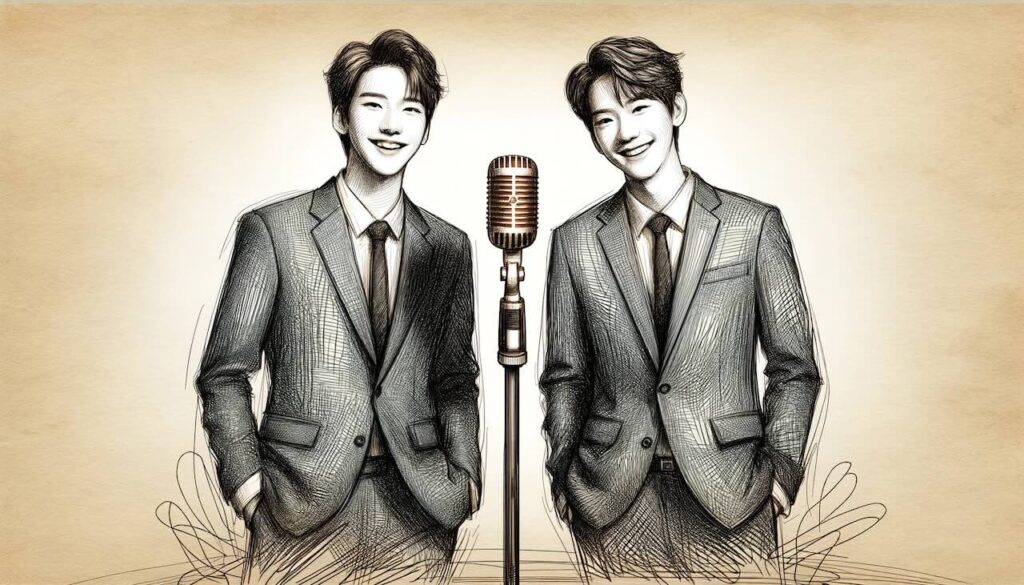Two Styles, One Goal: Making Japan Laugh
Japanese comedy is rich, vibrant, and deeply woven into the fabric of everyday life.
Among its many forms, two styles stand out: Manzai and Konto.
Both aim to spark laughter, but their approaches, rhythms, and styles are distinctly different.
Let’s dive into these beloved traditions — and trace the lively history behind them.
Manzai: The Art of Rapid-Fire Wit
Manzai is a dynamic, high-energy style of comedy performed by two people:
- Boke: The funny man who says silly, absurd, or mistaken things.
- Tsukkomi: The straight man who reacts sharply, correcting or scolding the boke.
This back-and-forth rhythm creates a fast-paced dance of words, timing, and chemistry.
When performed well, it feels almost like watching an intricate, witty ping-pong match — one that leaves audiences in stitches.
Konto: Comedy That Tells a Story
Konto, by contrast, is more like a theatrical comedy sketch:
- Set in specific, often absurd scenarios
- Makes use of props, costumes, and physical gags
- Focuses on situational humor and character-driven storytelling
Rather than quick banter, konto draws you into little worlds where misunderstandings and odd characters create the laughs.
A Brief History of Manzai
Manzai’s roots run deep, and its journey through Japanese history is as colorful as its performances:
- Edo Period (1603–1868): Street performers known as maai entertained with witty exchanges, laying early groundwork.
- Meiji Era (1868–1912): The rise of detchi-gei — young apprentices using humor to attract customers to shops — shaped the evolving style.
- Taisho Period (1912–1926): Manzai exploded in popularity in vaudeville theaters, with legendary duos like Yokoyama Entatsu & Hanabishi Achako setting the standard.
- Post-World War II: Radio and then television brought Manzai into homes nationwide, launching stars like Tani Kei & Nishikawa Kiyoshi into the public eye.
Comedy Today: Still Evolving, Still Beloved
Both Manzai and Konto continue to adapt to new times:
- The M-1 Grand Prix: An annual competition that crowns the best new Manzai talent, watched by millions.
- Social Media: A new stage where comedians experiment, connect, and build audiences beyond traditional TV.
- Online Content: YouTube, streaming platforms, and podcasts allow for even more diverse, creative comedic expressions.
Despite changing formats, the heart of Japanese comedy — sharp timing, cleverness, and big-hearted laughter — remains the same.
The Cultural Power of Laughter
Manzai and Konto aren’t just entertainment; they’re a vital part of Japanese society:
- Stress Relief: Offering an escape from the pressures of daily life.
- Social Commentary: Delivering insight into societal issues through humor.
- Connection: Bringing people together across ages and backgrounds.
Understanding these styles gives us a window into Japanese culture, language, and even social dynamics — all through the universal language of laughter.
Final Thoughts: Dive Into the World of Japanese Comedy
As we explore the intricate rhythms of Manzai and the colorful stories of Konto, one thing becomes clear:
While styles differ, the mission remains the same — to make people laugh.
So why not jump in?
Whether you’re drawn to the lightning-fast wordplay of Manzai or the whimsical world-building of Konto, discovering Japanese comedy is a joyful way to connect with a rich cultural tradition.
In the end, no matter the language, laughter always brings us closer.


